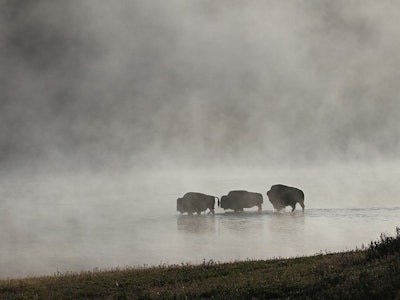130,000-Year-Old Fossil Has Been Anointed "Mother of All Bison"
The fossil further solidifies the Bering Land Bridge crossing theory.

Scientists are calling what is believed to be the oldest bison fossil ever recorded the “mother of all bison,” a huge discovery in explaining not only where these massive animals came from but also the “land bridge” that once connected North America to Asia.
In their study, published in the journal The Proceedings of the National Academy of Science, paleontologist Duane Froese and his team reveal that bison traveled to North America in two waves: the first wave between 195,000 and 135,000 years ago, the second between 45,000 to 21,000 years ago. Both waves align with geological records of very low sea levels, low enough to expose the Bering Land Bridge.
“It only takes about 40 to 50 meters lower sea level to expose parts of the land bridge,” Froese tells Inverse. “A single generation could have made the journey, but we don’t know if that’s what happened. They could have lived on the land bridge also.”
The dug up bison skull from Yukon.
The Bering Land Bridge is a strip of land that is believed to have connected Siberia and Alaska. Scientists theorize that during periods when the bridge was exposed, there were mass exchanges of wooly mammoths, wolverines, giant beavers, and even humans from one continent to the other.
The Bring Land Bridge Connects Russia and North America across the Pacific Ocean.
In 2006, Froese, a professor at the University of Alberta, and his team uncovered the remains of a steppe bison in northern Yukon, Canada. The fossils were so old and decrepit that they couldn’t read their DNA to identify their age. It took over a decade to figure out, but Froese and his team finally did it, thanks to a technique called hybridization capture, which involves taking genome fragments from the remains and comparing them to modern day species. Froese compared the genome of the Yukon bison to a long-horned bison fossil found in Snowmass, Colorado dating back 120,000 years ago. Froese then compared that data to ten modern day bison to form a “molecular clock,” ultimately helping to figure out the age of the fossil and to prove the animal’s usage of the Bering Land Bridge.
“By having ‘old fossils’ or at least well-dated older fossils we can constrain the molecular clock rate, rather than using an estimate of that rate,” Froese tells Inverse. “This allows us greater confidence in estimating the root of the tree or the ‘mother of all bison’.”
Bison were once plentiful across the Western prairies of the United States, but were hunted to near extinction in the 19th century for their hides and meat. Thanks to conservation efforts like the National Bison Legacy Act, these large, shaggy mammals have made a comeback, with North America boasting about a half million of the animals.